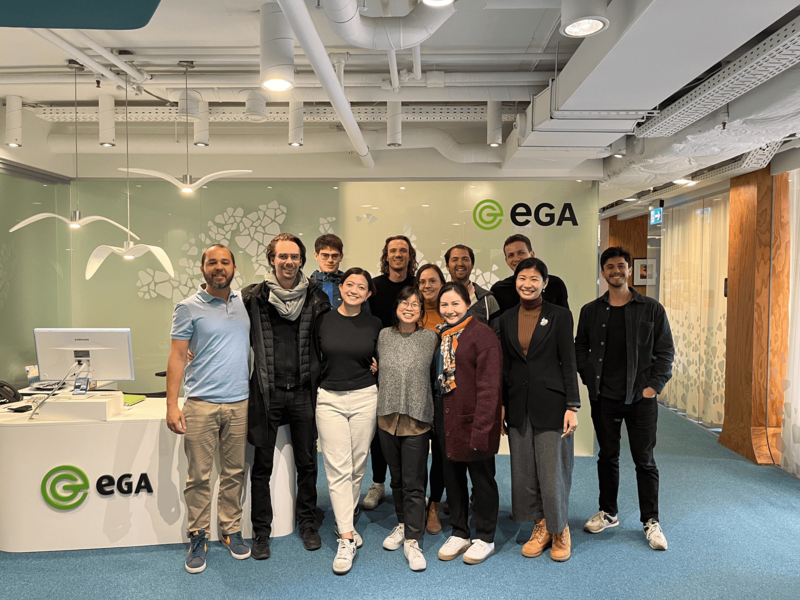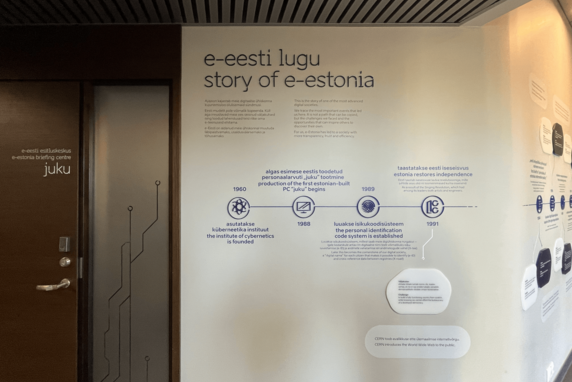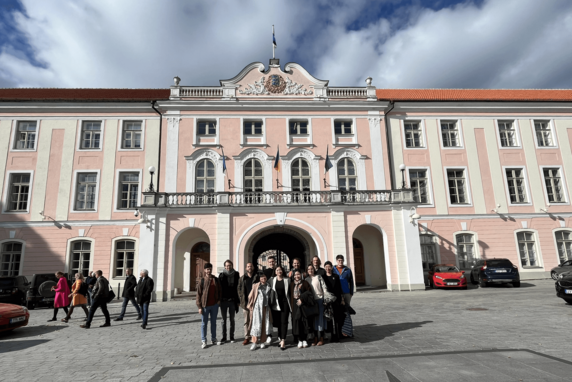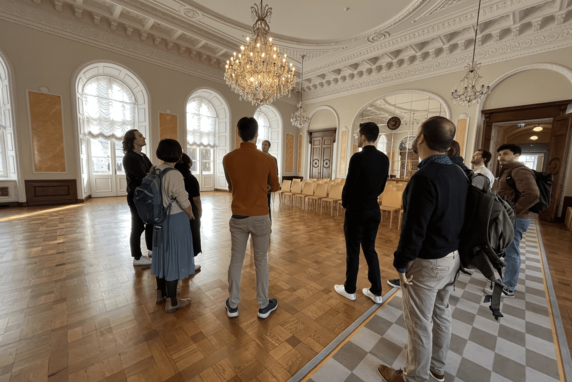
On the edge of the European Union lies Estonia, a country leading in digital governance with one of the most advanced digital societies in the world. From doing your taxes in three minutes to never having to wait in line for another government service, how lucrative is the e-resident program? And how transferable is this for other nations?
During a three day workshop, twelve Hertie School students from the Master’s of Public Policy (MPP), Master’s of International Affairs (MIA) and Executive Master’s of Public Administration (EMPA) programs visited Tallinn, Estonia and explored different institutions to learn more about digital governance in the country. The workshop was organised by Dr. Keegan McBride, former Postdoctoral Researcher at the Centre for Digital Governance, and Johanna Scholz, current EMPA student (‘23). From visiting the e-Estonia Briefing Center to the Estonian Parliament, the workshop was filled with exciting opportunities to learn more about Estonia’s progress, in addition to visiting an incredible city filled with history and beauty.
How it all began
After gaining independence from the Soviet Union in 1991, the small Baltic state was in a position to rebuild their infrastructure. The country was relatively poor and the young leadership laid the perfect grounds for modernisation. Even back then, digital solutions were associated with a lower cost and higher efficiency. The “Tiger Leap” in the late ‘90s (Tiigrihüpe) was a significant step towards a digitalised nation, with the government investing heavily in expanding computer access and internet infrastructure across schools. This provided a headstart in digital literacy for its citizens.
The workshop began with our first site visit to Tallinn University of Technology (TalTech), where we met several professors from the eGovernance Lab as well as experts from Cybernetica. We discussed Estonia’s digital architecture and government ecosystems, in particular focusing on X-Road, the backbone ecosystem solution of e-Estonia that provides unified and secure data exchange between organisations. X-Road is an “open source data exchange layer system”, that enables interoperability, confidentiality, coordination and integrity between the public and private sectors. The architects of e-Estonia and X-Road were employees of Cybernetica, and the company continues to be a key partner in developing e-gov solutions. The public-private partnership (PPP) was the fastest way to build a foundation of digital governance and the chosen decentralised system was key to the success in scalability and security issues. Hence, the PPP was essential for funding, resources implementation and expansion of Estonia’s digital infrastructure.
Estonia today
With a population of 1.3 million, Estonia has been able to benefit from its small size in leveraging data and automation to improve education, health care and social services. Nearly all citizen services can be completed online, except for getting married or divorced. Some other interesting facts we learned about e-Estonia are that:
- 99% of bank transactions are online
- 99% of public services are online with 24/7 access
- 2.7 billion+ queries are made annually via X-Road
The next step on the digitalisation journey is the Bürokratt, a virtual assistant that is supposed to support citizens with public services and seeks to reduce government inefficiency.
On the second day of the trip we also visited the Estonian Parliament and the Super Ministerium Building. We met with Raimond Kaljulaid, Member of the Social Democratic Party (SDE) and representatives from the Ministry of Social Affairs, Ministry of Economic Affairs and Communications and Accelerate Estonia, a governmental innovation lab. The insights we received were more objective, highlighting both the strengths but also the challenges of e-Estonia. Naturally, the goal was to to improve citizens’ lives and to proactively improve social services. However, challenges included bridging the digital divide between rural and urban areas and between different age groups. Improving collaboration between the private and public sector post-pandemic has also been crucial in order to lower the barriers for new companies to enter the health sector. Another challenge has been ensuring proper maintenance of the infrastructure and preventing a skills shortage of data experts, so that the system can continue to run smoothly. Cyberattacks continue to be a threat for digital infrastructures and preventative measures, allocated resources and digital literacy are necessary to avoid future attacks. Lastly, perhaps not all services should be fully digitalised. Some services benefit from a “human touch” and it can be frustrating for citizens to constantly interact with a digital interface. Especially in the social sector, the human element should not be fully eliminated.
Kate Yang (EMPA 2021) states that, “As a researcher, I'd suggest that in addition to the massive implementation and aggressive expansion plans, subjects such as civic engagement and the well-being framework could have been explored further”.
What about e-Germany?
A recurring theme we encountered during the trip was the sense of skepticism about digital governance that both our students and other German delegations who visited Estonia brought with them. Was there a potential for the country to become e-Germany? Well, it seems unlikely. The main red flags that were mentioned included data protection and privacy issues. In addition, there is a general aversion to new technologies and any platform that saves personal data. This is quite ironic, since Estonia actually focuses on human-centric digital governance and transparency, which means each citizen can see their personal data and administer who has searched for it. Another concern that the e-Governance Academy, a non-profit foundation that assists public sector institutions in digital transformation, noted was that Germany has a strong legacy system. This means that it is difficult to implement new solutions and a new foundation is required to build a digital governance infrastructure. Additionally, the size and federal fragmentation of Germany makes it harder to establish strong solutions that allow exchanging of data across sectors. An anecdote from a representative summarised the issue: “I was at a seminar in Germany, and everyone was talking about the risks, but few people spoke about the benefits. Germans worry too much about certain things that are not that bad”. Perhaps that is something for the German government to consider.
Luciano Mejia Peroni (MPP 2024) noted that, “The Estonian model has been so successful because it has the interest of citizens at its core. All their services are thought out of the user perspective, with the objective of improving user experience. That seemed to be a fundamental difference between the Estonian approach and that of many other governments, where, it seems, protocol and bureaucracy are given priority over the users' experience”.
Overall, the trip provided a holistic opportunity to gain insights into e-Estonia from multiple perspectives of the public and private sectors, academia and other stakeholders. The key takeaways were that history and context matters. We cannot simply copy and paste the Estonian model to other EU nations but factors like legacy systems, trust and openness to change have to be considered. “You cannot build a house starting with windows”, was a strong sentiment that summarised the lacking approach of other nations. The right leadership and mindset is needed to build a new foundation of digital governance, to accept and manage risks and to engage with citizens to create something that will benefit them. Interoperability, decentralisation and integrity are three concepts that were vital to establishing a system in Estonia that works well together and optimises functions for users. Finally, the benefit from public-private partnerships should not be underestimated in the development of businesses and digital services. Although Estonia still faces future challenges to its system, e-Estonia showcases an inspiring success story, from which other governments can learn. And remember, the next time you are moving house and must wait several months for your Anmeldungstermin, just take two minutes and imagine - voilà! In the same amount of time, you would have already been registered and completed your taxes in Estonia.
Thank you to Johanna and Keegan for their organisation and thank you to all the participants: Arianna Friedman, Ashley Chia, Felipe Wolf, Juan Esteban Sanabria, Julian Heiss, Kate Yang, Luciano Mejia Peroni, Marc Girshgorn, Maximilian Kupi and Natascha Schoepl.



